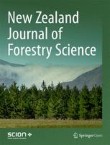Use of LiDAR to estimate stand characteristics for thinning operations in young Douglas-fir plantations
Light Detection and Ranging (LiDAR) has been successfully used to describe a wide range of forest metrics at local, regional and national scales. However, little research has used this technology in young Doug...
